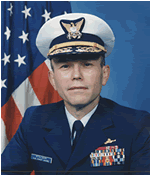
James Milton Loy is a retired United States Coast Guard admiral who served as Acting United States Secretary of Homeland Security in 2005 and U.S. Deputy Secretary of Homeland Security (DHS) from December 4, 2003, to March 1, 2005. Prior to his appointment as the DHS Deputy Secretary, he served as the second administrator of the Transportation Security Administration from 2002 to 2003, and before that as the Commandant of the U.S. Coast Guard from 1998 to 2002.
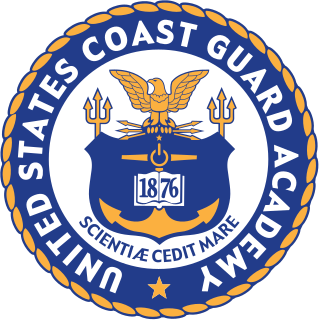
The United States Coast Guard Academy (USCGA) is the service academy of the United States Coast Guard in New London, Connecticut. Founded in 1876, it is the smallest of the five U.S. service academies and provides education to future Coast Guard officers in one of nine major fields of study. Unlike the other service academies, the Coast Guard Academy does not require a congressional nomination for admission.

Thomas Hansen Collins is a former United States Coast Guard admiral who served as the 22nd Commandant of the U.S. Coast Guard from May 2002 to May 2006.

The Long Range Interceptor (LRI) is an 11-meter high speed launch vessel designed to be deployed from United States Coast Guard cutters via a rear launching ramp. The Long Range Interceptor is an aluminum rigid hull inflatable boat (RHIB), powered by Ultrajet brand water-jets, for intercepting and boarding suspect vessels. It mounts a radar, special shock-proof seats, and can travel at 35 knots. They can be armed with machine guns or grenade launchers, and can be equipped with ballistic panels for crew protection when required.

The USCGC Bibb (WPG-31) was a 327-foot (100 m) Secretary-Class Coast Guard ship commissioned in 1936. Seven similar "combat cutters" were built and named for secretaries of the United States Treasury. Bibb was named for U.S. Secretary of the Treasury George M. Bibb.
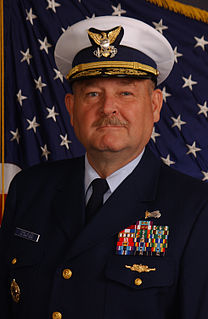
Thad William Allen is a former United States Coast Guard admiral who served as the 23rd Commandant of the Coast Guard. Allen is best known for his widely praised performance directing the federal response to hurricanes Katrina and Rita in the Gulf Coast region from September 2005 to January 2006, and for his role as National Incident Commander of the Unified Command for the Deepwater Horizon oil spill in the Gulf of Mexico in 2010. Robert J. Papp, Jr. succeeded him as Commandant on 25 May 2010, in a change of command ceremony.
This article covers the organization of the United States Coast Guard.

Admiral Robert J. Papp Jr. is a retired United States Coast Guard admiral and served as the 24th Commandant of the U.S. Coast Guard. He led the largest component of the United States Department of Homeland Security, with 42,000 active duty, 8,200 Reserve, 8,000 civilian, and 31,000 Auxiliary personnel.
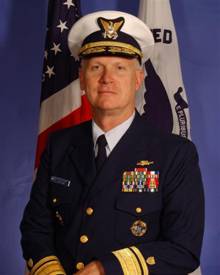
Timothy S. Sullivan is a retired rear admiral in the United States Coast Guard who served as the Deputy Commander, Pacific Area Coast Guard Defense Forces West. He was assigned as Commander of the Pacific Maintenance and Logistics Command, but was detached from those duties while serving as Deputy PACAREA. He has also served as the First Coast Guard District Commander and Commander, Maritime Defense Command One as well as the Senior Military Advisor to the Secretary of Homeland Security serving as the primary coordinator between the Departments of Defense and Homeland Security as well as operational advisor to the Secretary during Hurricanes Katrina and Rita.

USCGC Waesche (WMSL-751) is the second Legend-class cutter of the United States Coast Guard.

Ronald J. Rábago is a retired United States Coast Guard Rear Admiral who in 2006 became the first person of Hispanic American descent to be promoted to flag rank in the United States Coast Guard. He retired as the Assistant Commandant for Engineering and Logistics and the United States Coast Guard's Chief Engineer in 2014.

Erroll M. Brown is a retired rear admiral in the United States Coast Guard. Brown was the first African-American promoted to flag rank in the Coast Guard.

Cari Batson Thomas is a retired Rear Admiral in the United States Coast Guard and a 1984 graduate of the U. S. Coast Guard Academy. On Friday January 22, 2010 Thomas was ceremoniously advanced to Rear Admiral and became the third recent female commander of the training center to be advanced to a flag officer. Her final assignment was Assistant Commandant for Human Resources at the Coast Guard Academy.

James A. Watson is a United States Coast Guard Rear Admiral.
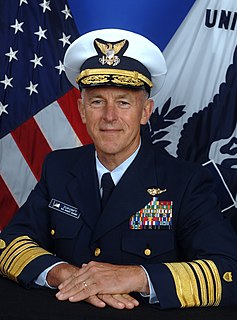
Paul Frederick Zukunft is a retired United States Coast Guard admiral who served as the 25th Commandant of the Coast Guard. He was confirmed by the U.S. Senate as the Commandant, with the rank of Admiral, in May 2014 and relieved Admiral Robert J. Papp Jr. as Commandant on 30 May 2014. Prior to his selection as Commandant, he served as Commander, Coast Guard Pacific Area. In this position, Zukunft was the operational commander for all U.S. Coast Guard missions within the half of the world that ranges from the Rocky Mountains to the waters off the East Coast of Africa. He concurrently served as Commander, Defense Force West and provided U.S. Coast Guard mission support to the U.S. Department of Defense and Combatant Commanders.
Hispanics in the United States Coast Guard can trace their tradition of service to the early 19th century, when they initially performed duties at light house stations as keepers and assistant keepers in its predecessor services. Hispanic is an ethnic term employed to categorize any citizen or resident of the United States, of any racial background, of any country, and of any religion, who has at least one ancestor from the people of Spain or is of non-Hispanic origin, but has an ancestor from Mexico, Puerto Rico, Cuba, Central or South America, or some other Hispanic origin. The three largest Hispanic groups in the United States are the Mexican-Americans, Puerto Ricans, and Cubans.
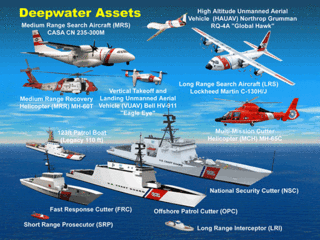
The Integrated Deepwater System Program was the 25-year program to replace all or much of the United States Coast Guard's equipment, including aircraft, ships, and logistics and command and control systems. The $24 billion program lost authorization in Fiscal Year 2012 and is officially defunct.
Captain Charley L. Diaz is a 30-year United States Coast Guard veteran who served on Active Duty from 1982 to 2012. Diaz is best known for leading the crew of the USCGC Sherman (WHEC-720) in the seizure of the Panamanian freighter GATUN off the coast of Panama in March 2007, which netted nearly 20 tons of cocaine worth an estimated $600 million. It was the largest maritime drug bust in US history.

In the United States Navy, United States Coast Guard, United States Public Health Service Commissioned Corps (USPHS), and National Oceanic and Atmospheric Administration Commissioned Officer Corps, captain is the senior-most commissioned officer rank below that of flag officer. The equivalent rank is colonel in the United States Army, Air Force, and Marine Corps.
